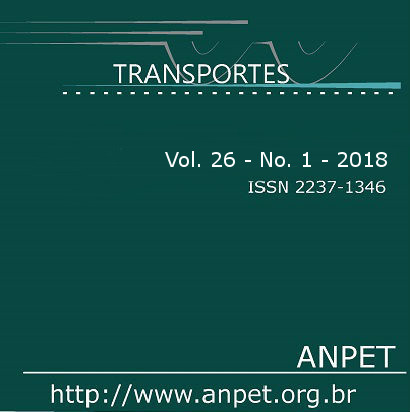Introdução do coeficiente de uniformidade para avaliação de revestimentos asfálticos do tipo tratamentos superficiais
DOI:
https://doi.org/10.14295/transportes.v26i1.1371Keywords:
Tratamento superficial por penetração, Defeitos, Perda de agregado, Coeficiente de uniformidade.Abstract
The surface treatments are the most used type of coating in Brazil in Low Traffic Volume Roads, more specifically the chip seal. After field and laboratory investigations, it was observed that the main defects of chip seals are aggregate loss (or raveling) and bleeding, which can affect its performance and increase considerably the paving costs. In Brazil there are still few studies of design and performance of chip seals in the laboratory phase to predict these two defects. Thus, it was investigated materials and methodologies employed at North Carolina State University and it was verified that the coefficient called Performance-Based Uniformity Coefficient (PUC) is a parameter associated with the granulometric distribution of the aggregate that has potential to predict bleeding and raveling of this type of coating. It was concluded that PUC is an excellent parameter to be introduced in chip seal design procedures and that the ranges recommended by DNIT to chip seals should be reviewed.Downloads
References
Adams, J. M. (2014) Development of a Performance-Based Mix Design and Performance-Related Specification for Chip Seal Surface Treatments. Tese (doutorado). Civil Engineering, North Carolina State University. Raleigh.
ASTM (2011) D7000 – 11 Standard Test Method for Sweep Test of Bituminous Emulsion Surface Treatment Samples. ASTM In-ternational. West Conshohocken.
Chaturabong, P. (2014) Development of the Loaded Wheel Tracking Test (LWT) for Evaluating Bleeding in Chip Seals and Relation-ship to Emulsion Residue Rheology. Tese (doutorado). Civil & Environmental Engineering, University of Wisconsin. Madison.
CNT (2018) Boletim estatístico. Confederação Nacional do Transporte (CNT). Disponível em: <http://www.cnt.org.br/Boletim/boletim-estatistico-cnt>. (Acesso em: 02 março 2018).
DER-CE (2017). Informativo gerencial 2017. Disponível em: <http://www.der.ce.gov.br/wp-content/uploads/sites/30/2018/01/informativo_gerencial2017.pdf >. (Acesso em: 19/04/2018).
DNIT (2012) ES 146/2012 Pavimentação asfáltica – Tratamento superficial simples – Especificação de serviço. Rio de Janeiro.
DNIT (2006) Manual de Pavimentação. Publicação IPR – 719. Rio de Janeiro.
Larsen, J. (1985) Tratamento Superficial na Conservação e Construção de Rodovias. ABEDA. Rio de Janeiro.
Lee, J. S. e Kim, Y. R. (2010) Evaluation of Performance and Cost-Effectiveness of Polymer-Modified Chip Seals. Transportation Research Record: Journal of the Transportation Research Board, v. 2150, Transportation Research Board of the National Academies. Washington, D.C., p. 79–86. DOI: 10.3141/2150-10
Lee, J. S. e Kim, Y. R. (2009) Performance-Based Uniformity Coefficient of Chip Seal Aggregate. Transportation Research Rec-ord: Journal of the Transportation Research Board, v. 2108, Transportation Research Board of the National Academies, Washington, D.C., p. 53–60. DOI: 10.3141/2108-06
Lee, J. S. e Kim, Y. R. (2008) Understanding the Effects of Aggregate and Emulsion Application Rates on Performance of As-phalt Surface Treatments. Transportation Research Record: Journal of the Transportation Research Board, v. 2044, Trans-portation Research Board of the National Academies. Washington, D.C., p. 71–78. DOI: 10.3141/2044-08
Lee, J.; Kim, Y. (2010) Optimal Distribution of Rolling Coverage in Multiple Chip Seals. Transportation Research Record: Journal of the Transportation Research Board, v. 2150, p. 70–78. DOI: 10.3141/2150-09.
Loiola, P. R. R. (2009) Estudo de Agregados e Ligantes Alternativos para Emprego em Tratamentos Superficiais de Rodovias. Dis-sertação (mestrado). Departamento de Engenharia de Transportes, Universidade Federal do Ceará. Fortaleza.
Moraes, R.; Bahia, H. (2013) Effects of Curing and Oxidative Aging on Raveling in Emulsion Chip Seals. Transportation Re-search Record: Journal of the Transportation Research Board, v. 2361, n. 2361, p. 69–79. DOI: 10.3141/2361-09
Nogami, J. S.; Villibor, D. F. (1995) Pavimentação de Baixo Custo com Solos Lateríticos. Editora Villibor. São Paulo.
Pereira, S. L. O. (2010) Avaliação de Tratamentos Superficiais de Rodovias através de Análise de Laboratório. Monografia (inicia-ção científica). Departamento de Engenharia de Transportes, Universidade Federal do Ceará. Fortaleza.
Pereira, S. L. O. (2013) Avaliação dos Tratamentos Superficiais simples, duplo e triplo de rodovias através do emprego de diferen-tes agregados da região metropolitana de Fortaleza. Dissertação (mestrado). Departamento de Engenharia de Transportes, Universidade Federal do Ceará. Fortaleza.
Silva, R. C. (2016) Introdução de um novo coeficiente para análise de desempenho dos tratamentos superficiais a partir dos estu-dos desenvolvidos nos Estados do Ceará/Brasil e Carolina do Norte. Monografia (iniciação científica). Departamento de En-genharia de Transportes, Universidade Federal do Ceará. Fortaleza.
Transit New Zealand (2005) Chipsealing in New Zealand. ISBN: 0-478-10562-2.
Downloads
Published
How to Cite
Issue
Section
License
Authors who submit papers for publication by TRANSPORTES agree to the following terms:
- The authors retain the copyright and grant Transportes the right of first publication of the manuscript, without any financial charge, and waive any other remuneration for its publication by ANPET.
- Upon publication by Transportes, the manuscript is automatically licensed under the Creative Commons License CC BY 4.0 license. This license permits the work to be shared with proper attribution to the authors and its original publication in this journal.
- Authors are authorized to enter into additional separate contracts for the non-exclusive distribution of the version of the manuscript published in this journal (e.g., publishing in an institutional repository or as a book chapter), with recognition of the initial publication in this journal, provided that such a contract does not imply an endorsement of the content of the manuscript or the new medium by ANPET.
- Authors are permitted and encouraged to publish and distribute their work online (e.g., in institutional repositories or on their personal websites) after the editorial process is complete. As Transportes provides open access to all published issues, authors are encouraged to use links to the DOI of their article in these cases.
- Authors guarantee that they have obtained the necessary authorization from their employers for the transfer of rights under this agreement, if these employers hold any copyright over the manuscript. Additionally, authors assume all responsibility for any copyright infringements by these employers, releasing ANPET and Transportes from any responsibility in this regard.
- Authors assume full responsibility for the content of the manuscript, including the necessary and appropriate authorizations for the disclosure of collected data and obtained results, releasing ANPET and Transportes from any responsibility in this regard.









